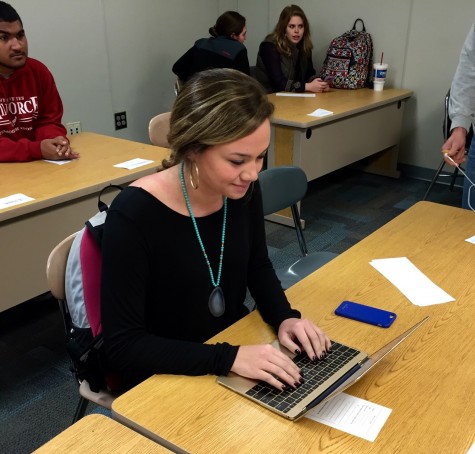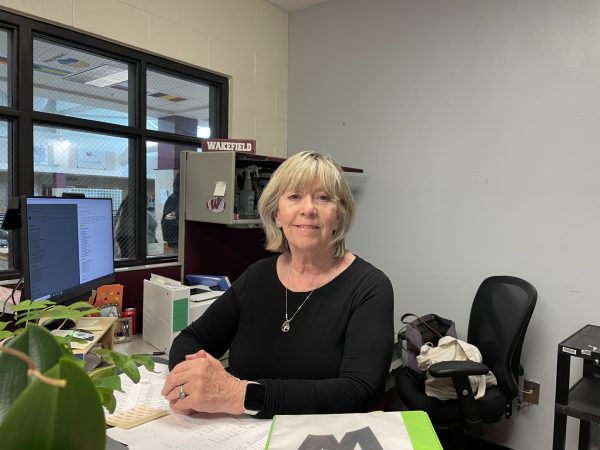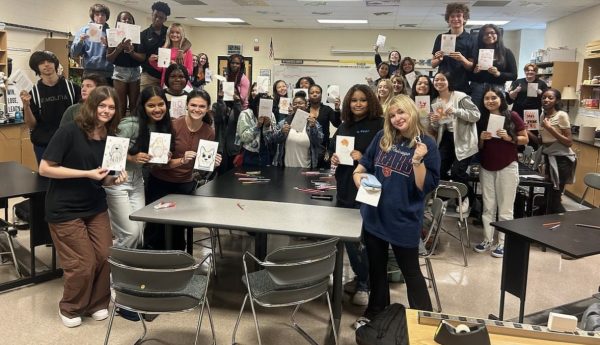Technology takes a turn with BYOD
The expansion of the Bring Your Own Device policy (BYOD) in Wake County schools allows students to utilize twenty-first century technology in the classroom.
December 8, 2015

Senior, Lauren Talley, brings her own laptop to work during class.
As technology continues to expand in this modern age, many schools have chosen to incorporate personal devices in their classrooms. Numerous Wake County schools have shifted from traditional teaching tactics to having students bring in their own devices such as laptops, iPads, and iPhones. This policy, known as Bring Your Own Device (BYOD), has allowed students to access information in a way that might have otherwise not been possible due to low budgets.
Dorothy Corrigan, Media Center Specialist, agrees that the BYOD policy has made a difference in giving students access to necessary equipment.
“We don’t have the budget to purchase devices for learning to be one-to-one,” said Corrigan. “[BYOD] will speed up, or at least increase, the number of usable technology that students can use in the classroom.”
Having students bring their own devices to school has made it easier for teachers to create lesson plans that involve technology without having to provide additional equipment.
“One way to [catch up technologically] without investing in enough devices for every student in the school was to have students bring their own device,” said science teacher Caleb Zander. “There’s a lot more you can do instructionally with a device, so it’s helpful for them to bring their own.”
History teacher Jennifer Ward, believes that expanding this policy will better prepare students for life beyond high school.
“I think that [BYOD] will increase the availability of technology,” said Ward. “It will help with students’ 21st century skills, so that when they get into college or go out into the workforce, they are more of a ‘digital’ citizen who is used to using technology.”
While the BYOD policy has helped Wake County schools cut down on the devices they need to provide to students, teachers are still working to establish a system that creates consistency throughout the school, while also pinpointing the aspects of the policy that could become problematic.
“We can see that students need that consistency,” said Corrigan. “ If they used devices in one classroom, why can’t they use that in another? If there’s a visible sign of where we are in technology in each classroom, then that will avoid that problem.”
Faculty have come up with a number of ways to ease the BYOD policy into the school to make the rules of technology use clear.
“We have ‘Ws’ that we’re going to use in classrooms that are different colors like a traffic light,” said Corrigan. “A red ‘W’ would mean that no devices can be out, a yellow W would mean devices should be; easily accessible, and a green W would mean to get your device out when you come into class.”
Having students know when it is acceptable to have a device in the classroom and when it is not is one reason Maureen Stockdale, science teacher, believes the BYOD policy will help regulate its use.
“Currently, the use of electronic devices is at the discretion of the classroom teacher,” said Stockdale. “BYOD just reinforces that – but also eliminates the guess work of whether it is okay to use electronics on any given day.”
Not only is consistency an issue with students bringing their own devices, but the technology does not always function as planned.
“There are some struggles with just formatting and keeping students engaged,” said Zander. “If you have a young student who’s not independent and self-regulated, they’re going to get off task and they’re going to miss the point.”
Despite these difficulties, the BYOD policy has impacted students’ productivity and work ethic in classrooms.
“If the lesson is already prepared,” said Ward, “students are watching that lesson individually, teachers can give more one on one attention to a student who is struggling with something, rather than teaching the class something at the same time. It frees up the teacher to focus on students that are having certain issues.”
With the addition of a new school-wide policy, there is bound to be some resistance when putting it into effect. However, teachers remains optimistic.
“ The hope is that it will be used appropriately and selectively when it enhances instruction and learning,” said Stockdale.
The main goal is for technology to simplify the overall educational process for both students and teachers.
“On the start-up end, it takes a lot more work to get going,” said Zander. “I think it’s worth it; students do seem to use [technology] better and it is easier for everyone involved.”














